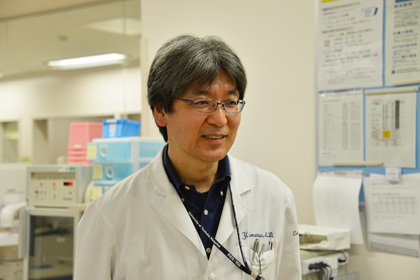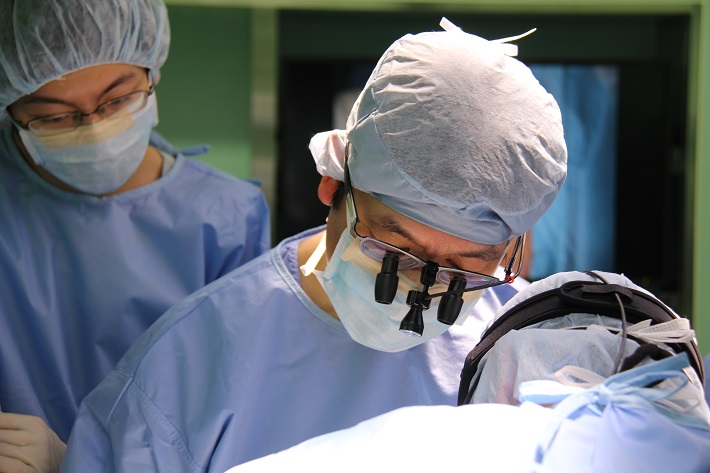TSUKUBA FRONTIER
#05 Saving Tiny Lives One by One: Deep Trust and Judgment at the Cutting Edge of Medicine
A baby born in May 2013 weighing just 1000 g had a nearly one-centimeter hole in her heart. After two operations and round-the-clock care, the pediatric ICU team at the University of Tsukuba Hospital was miraculously able to save her life. Heart surgery is rarely performed for babies so small anywhere in the world, and requires a series of difficult decisions.
Professor HIRAMATSU Yuji, Faculty of Medicine

■ An unprecedented challenge
It is not rare for babies to be born with a hole in the wall between the right and left ventricles of the heart (ventricular septal defect) but surgery is typically delayed until the baby grows to 3 to 4 kg. In this case, however, the baby was extremely premature, weighing only about 1 kg, and her life was in immediate danger. It was clear that anything other than immediate surgery would be too late. There was only one decision to be made.
However, it was no easy task to directly insert a scalpel into a heart about the size of a quail egg, so the first step the team took was to wrap tape around the pulmonary artery to constrict blood flow to the lungs. This procedure itself is common, but it is extremely difficult to wrap tape around a blood vessel only a few millimeters thick with very little space around it. The atmosphere was tense while the team completed this operation that must be accurate to the millimeter.
The team performed the second operation four months later when the baby weighed just under 3 kg. This time, the team directly closed the hole in the heart. They applied an artificial patch to the hole and stitched around it with thread. The stitches serve the same purpose as in sewing, but cannot be redone. Dexterity is also required as the process must be completed in about 15 to 30 minutes.
The operation was a success, but the baby's condition remained unstable. Her heart stopped beating later that day, but the team was somehow able to keep her alive with a six-day combination of cardiac massage and assisted circulation. After that point, she gradually recovered and was discharged in good health three months later.
■ Teamwork on display in the pediatric ICU

This kind of treatment requires more than just surgery. The first team involved in saving the lives of newborn babies is the department of neonatology. They perform delicate tasks such as administering intravenous drips and intubating for ventilation within the incubator. Then it is time for the surgeons. A team of at least seven to eight people, including not only the surgeon but also an anesthesiologist, doctors in charge of cardiopulmonary machines and others, nurses, and assistants, must gather in the operating room. Treatment can only succeed when each team member, including those in charge of postoperative care, carries out their professional role to the best of their ability.
The treatment for the baby whose case was described in the previous section was performed at the pediatric ICU (intensive care unit) of the University of Tsukuba Hospital. The unit specializes in advanced emergency medicine, and handles pediatric patients with serious conditions that cannot be treated at other hospitals. Therefore, they never turn down a request for acceptance. All departments are on call to ensure they can respond at any time, and the eight beds are almost always full. This unit is an amazing place that cultivates the awareness and motivation required to lead the effort to save lives.
■ With the spirit of noblesse oblige
Communication is another essential element in treatment besides knowledge, skill, and equipment. At a pediatric ICU, it is particularly critical for the medical team to quickly build a trusting relationship with patients' parents. Parents are often forced to decide whether to consent to a potentially unsuccessful operation in situations where there are very few treatment options available. In these situations, rather than a detailed medical explanation, parents need to know how important the operation is to their child, and rely on the doctors' sincerity and dedication to doing whatever they can to save the child.
Of course, doctors are hesitant to harm little patients' bodies and want to avoid loss of life. They need to overcome such inner conflicts and pressures, and have a strong resolve to do what is best for their patients and accept the risks. This spirit of noblesse oblige is the professional responsibility of a doctor and is the first step toward building trust with patients and other members of the medical team.
■ Aiming as far as possible
Surgery is the medical discipline most directly involved with the patient's body. Prof. Hiramatsu chose to pursue heart surgery because he considered it to be the most difficult surgical discipline. The heart is truly indispensable to life, disease symptoms are varied, and numerous treatment techniques and tools are available, which means that this field requires complex thought processes and judgment. At first, Prof. Hiramatsu thought it was impossible, but that thought was what gave him the determination to push himself as far as possible toward his goal.
The subspecialty of pediatric heart surgery is even more difficult. Unlike with adult surgery, there are numerous variations on surgical techniques for congenital disorders, and each is like a brand new case. At his busiest, Prof. Hiramatsu is responsible for four to five patients at once, and his patients' treatment plans and progress are always on his mind. He repeatedly visualizes each operation in his head before he performs it. Every day brings a series of tense situations, as even decisions based on past cases and experience are questioned. That alone makes the feeling of accomplishment he gets from saving lives worth everything to him.
The job of a doctor demands persistence. Although he finds it frustrating to only be able to save one life at a time, Prof. Hiramatsu is striving to be a doctor who his medical students look up to and challenge themselves to surpass. With that secret hope in mind, he continues pushing himself even further forward.

Article by Science Communicator at the Office of Public Relations


